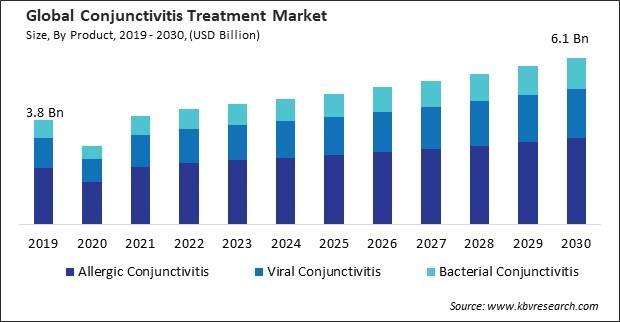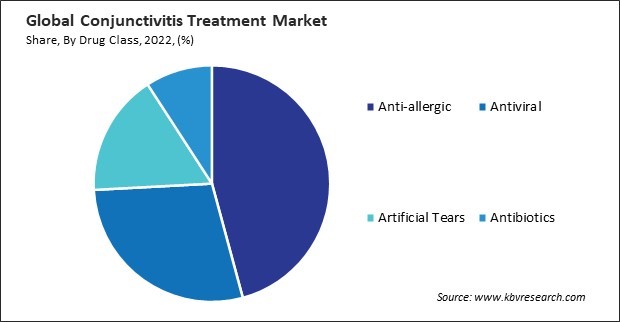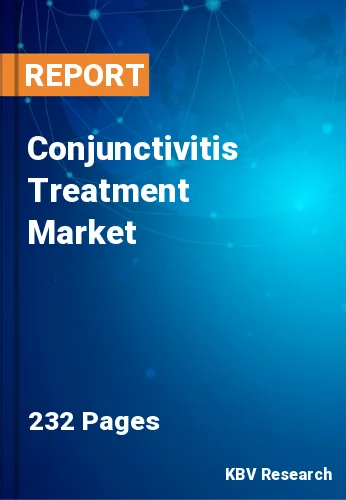“Global Conjunctivitis Treatment Market to reach a market value of USD 6.1 Billion by 2030 growing at a CAGR of 4.7%”
The Global Conjunctivitis Treatment Market size is expected to reach $6.1 billion by 2030, rising at a market growth of 4.7% CAGR during the forecast period.
Environmental allergens, viral infections, and other triggers contribute to a consistent demand for conjunctivitis treatment across the region. Therefore, the Nort America region captured $1,583.6 million revenue in the market in 2022. North America has a thriving pharmaceutical research and development (R&D) sector, with domestic and multinational pharmaceutical companies conducting innovative research in various therapeutic areas. According to Statistics Canada, in 2020, the R&D pharmaceutical sector contributed $15.9 billion to the Canadian economy in GVA, an increase of 5.8% from the $15.0 billion generated in 2019. The sector's direct impacts accounted for slightly less than half of this amount ($7.9 billion), an increase of 4.5% compared to the $7.6 billion produced in 2019. Indirect impacts accounted for 28.3% of the total GVA in 2020 and increased 6.1% to $4.5 billion, while induced impacts advanced 8.7% to $3.5 billion.

Higher healthcare expenditure often translates into improved access to healthcare services, including eye care. Individuals with conjunctivitis are more likely to seek medical attention and receive timely diagnosis and treatment when healthcare services are readily accessible. Increased healthcare spending allows for the adoption and integration of advanced medical technologies in diagnosing and treating conjunctivitis. Advanced diagnostic tools and treatment modalities contribute to more accurate assessments and effective management of the condition. Additionally, Improved awareness about the symptoms of conjunctivitis prompts individuals to seek medical attention at the early stages of the condition. The implementation of treatment in a punctual manner is facilitated by an early diagnosis, which prevents the development of conjunctivitis and mitigates the intensity of symptoms. Healthcare providers and organizations engage in community outreach programs to disseminate information about eye health. These programs may include eye screenings, educational seminars, the distribution of informational materials, and the raising of awareness about conjunctivitis and available treatments. These initiatives often include campaigns that highlight the importance of eye health and prompt individuals to seek appropriate treatment for eye conditions. Therefore, the rising awareness about eye health is driving the growth of the market.
However, the proliferation of antibiotic-resistant bacterial strains may result from the improper or excessive use of antibiotics to treat bacterial conjunctivitis. This means that the effectiveness of commonly used antibiotics diminishes over time, leading to challenges in treating bacterial infections. Antibiotic resistance narrows the range of effective antibiotics available for treating bacterial conjunctivitis. As resistance spreads, fewer viable treatment options may be available, making it difficult to manage infections with traditional antibiotics. Additionally, antibiotic resistance increases the risk of treatment failure. In cases where the causative bacteria are resistant to commonly prescribed antibiotics, the infection may persist, leading to unresolved symptoms and potential complications.
On the basis of disease type, the market is segmented into allergic conjunctivitis, bacterial conjunctivitis, and viral conjunctivitis. The allergic conjunctivitis segment recorded the largest revenue share in the market in 2022. The surge in allergic conjunctivitis cases drives an increased demand for anti-allergic medications in the market. The rising impact of allergic conjunctivitis prompts innovation in drug delivery systems within the market. This includes the development of advanced eye drop formulations, sustained-release technologies, and other delivery methods to enhance the efficacy and duration of anti-allergic medications.
Based on drug class, the market is divided into antibiotics, antiviral, anti-allergic, and artificial tears. In 2022, the anti-allergic segment garnered the highest revenue share in the market. Anti-allergic drugs, particularly antihistamines and mast cell stabilizers, are applied to provide symptomatic relief from common allergic conjunctivitis symptoms. These symptoms include itching, redness, tearing, and swelling. Antihistamines, which block the effects of histamine released during an allergic reaction, are a primary application in allergic conjunctivitis. These drugs help alleviate itching and reduce the overall inflammatory response.

Based on distribution channel, the market is categorized into hospital pharmacy, retail pharmacy, and online pharmacy. The retail pharmacy segment witnessed a noteworthy revenue share in the market in 2022. Retail pharmacies are often conveniently located in community settings, making them easily accessible to patients. This accessibility is crucial for individuals seeking over the counter (OTC) medications or prescription drugs for without the need for a hospital visit. Many cases of conjunctivitis, especially mild and uncomplicated forms, can be managed with over-the-counter medications. Retail pharmacies provide a wide range of OTC eye drops and treatments, allowing individuals to engage in self-care and promptly address mild symptoms without needing a healthcare provider visit.
Free Valuable Insights: Global Conjunctivitis Treatment Market size to reach USD 6.1 Billion by 2030
Region-wise, the market is analyzed across North America, Europe, Asia Pacific, and LAMEA. In 2022, the Asia Pacific region generated a substantial revenue share in the market. The Asia Pacific region is characterized by high population density, with a substantial number of people residing in urban and densely populated areas. This population density contributes to a higher prevalence of infectious diseases, including conjunctivitis, leading to an increased demand for treatment. Environmental factors like air pollution, dust, and exposure to allergens are prevalent in many parts of Asia Pacific. These environmental conditions can contribute to conjunctivitis, particularly allergic conjunctivitis, driving the demand for treatments to manage eye-related symptoms.
| Report Attribute | Details |
|---|---|
| Market size value in 2022 | USD 4.2 Billion |
| Market size forecast in 2030 | USD 6.1 Billion |
| Base Year | 2022 |
| Historical Period | 2019 to 2021 |
| Forecast Period | 2023 to 2030 |
| Revenue Growth Rate | CAGR of 4.7% from 2023 to 2030 |
| Number of Pages | 232 |
| Number of Tables | 360 |
| Report coverage | Market Trends, Revenue Estimation and Forecast, Segmentation Analysis, Regional and Country Breakdown, Porter’s 5 Forces Analysis, Company Profiling, Companies Strategic Developments, SWOT Analysis, Winning Imperatives |
| Segments covered | Disease Type, Drug Class, Distribution Channel, Region |
| Country scope |
|
| Companies Included | Novartis AG, Gilead Sciences, Inc., GlaxoSmithKline PLC, F. Hoffmann-La Roche Ltd., Merck & Co., Inc., Boehringer Ingelheim International GmbH, AbbVie, Inc., AFT Pharmaceuticals, Bausch Health Companies, Inc., Teva Pharmaceutical Industries Ltd. |
By Disease Type
By Drug Class
By Distribution Channel
By Geography
This Market size is expected to reach $6.1 billion by 2030.
Rapidly increasing healthcare expenditure are driving the Market in coming years, however, Concerns associated with antibiotic resistance restraints the growth of the Market.
Novartis AG, Gilead Sciences, Inc., GlaxoSmithKline PLC, F. Hoffmann-La Roche Ltd., Merck & Co., Inc., Boehringer Ingelheim International GmbH, AbbVie, Inc., AFT Pharmaceuticals, Bausch Health Companies, Inc., Teva Pharmaceutical Industries Ltd.
The expected CAGR of this Market is 4.7% from 2023 to 2030.
The Hospital Pharmacy segment is leading the Market; there by, achieving a market value of $3.3 billion by 2030.
The North America region dominated the Market, by region in 2022, and would continue to be a dominant market till 2030; there by, achieving a market value of $2.2 billion by 2030.
Our team of dedicated experts can provide you with attractive expansion opportunities for your business.

 Drivers
Drivers
 Restraints
Restraints
 Opportunities
Opportunities
 Challenges
Challenges
